Unveiling the April Birthstone: The Diamond's Legacy
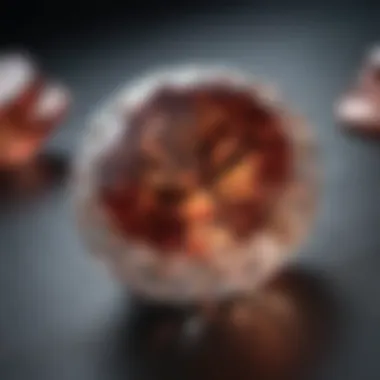

Intro
The April birthstone, diamond, symbolizes beauty, strength, and eternal love. The contrast between its rough form and polished radiance captures the essence of transformation. For those born in April, diamonds are not just gemstones; they represent resilience and emotional depth.
In this article, we will explore several dimensions of diamonds, delving into their characteristics, historical context, properties, and cultural significance. This exploration aims to provide a thorough understanding for gemstone enthusiasts, collectors, and potential buyers alike.
Gemstone Overview
Definition and Origins
Diamonds are carbon crystals formed under high-pressure and high-temperature conditions deep within the Earth's mantle. Their formation begins as carbon atoms bond in a three-dimensional structure. This structure gives diamonds their renowned hardness. The name "diamond" is derived from the ancient Greek word "adamas," which means unconquerable or indestructible.
Historical Significance
Diamonds have occupied a prominent role in human history for centuries. They have been prized by various civilizations, from the ancient Greeks who believed they were the tears of the gods, to Indian rulers who adorned themselves with these gems as symbols of power and wealth. In medieval Europe, diamonds were thought to possess protective qualities, warding off enemies.
Throughout history, diamonds have also been used as a symbol of enduring love, notably as the traditional stone for engagement rings. Their remarkable durability symbolizes the strength of a long-lasting relationship.
Gemstone Properties
Hardness and Durability
One of the standout features of diamonds is their hardness. They score a perfect 10 on the Mohs scale, making them the hardest natural substance known to man. This exceptional durability makes diamonds an ideal choice for daily-wear jewelry, such as engagement rings, because they resist scratching and damage.
Color and Clarity
Diamonds are often associated with their colorless appearance, but they can come in a range of hues. Color grading in diamonds typically varies from colorless (D) to light yellow or brown (Z). The more colorless the diamond, the more valuable it is considered.
When it comes to clarity, diamonds can contain internal imperfections or "inclusions". The clearer the diamond, the higher its quality. The clarity scale ranges from Flawless (no inclusions visible under 10x magnification) to Included, where inclusions are noticeable to the naked eye.
"The beauty of a diamond lies not only in its form, but also in its unique imperfections."
Understanding these properties is essential for anyone interested in purchasing diamonds, as they play a significant role in determining the overall value and appeal of a piece.
Foreword to Birthstones
The concept of birthstones holds a significant place in jewelry and culture. Traditionally, each month of the year is associated with a particular gemstone, believed to offer various benefits and meanings to those born during that month. This article will examine the April birthstone, diamond, within the wider context of birthstones, revealing its allure as well as its deeper implications.
Birthstones have a rich historical context, originating from ancient times. People believed these gemstones possessed special powers, providing protection and bringing good fortune. They were also thought to have healing properties, making them highly sought after. Understanding the cultural and personal significance of birthstones can enhance the appreciation for these beautiful gems.
Moreover, the assignment of birthstones is often based on various traditions, including astrology, numerology, or specific cultural interpretations. Each stone is believed to resonate uniquely with individuals depending on their birth month. This collective understanding informs our approach to diamonds as the April birthstone, further underscoring the importance of knowing the history and qualities of these remarkable stones.
In this section, we will delve deeper into the definition of birthstones and examine the historical context surrounding their significance.
Definition and Historical Context
Birthstones are typically defined as gemstones corresponding to each month of the year, aimed at celebrating the birth date of individuals. The historical roots can be traced back to biblical times when the breastplate of Aaron was adorned with twelve stones representing the twelve tribes of Israel. Later, these stones were linked to the zodiac signs. Over time, this evolved to create the modern lists we recognize today. Each month’s stone is believed to convey distinct attributes, meant to enhance or protect the person born during that time.
In ancient civilizations, gemstones were often associated with specific gods or were believed to grant special powers. The idea of wearing one's birthstone can be seen as a way of connecting with celestial energies and personal characteristics, leading to the belief that they offer good luck and fortune.
How Birthstones are Assigned
The assignment of birthstones varies based on cultural and historical factors. In 1912, the American National Retail Jewelers Association, now known as the American Gem Society, standardized the modern list of birthstones, but other traditions exist.
- Traditional Assignment: This follows a long-established listing, linking each stone to a specific month.
- Modern Assignment: It may include variations or substitutions to reflect trends more closely aligned with current preferences.
- Astrological Influence: Some tie birthstones to zodiac signs, adding a layer of astrological compatibility.
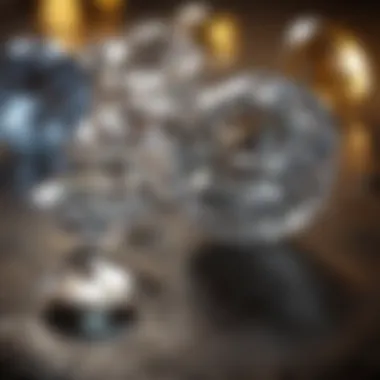
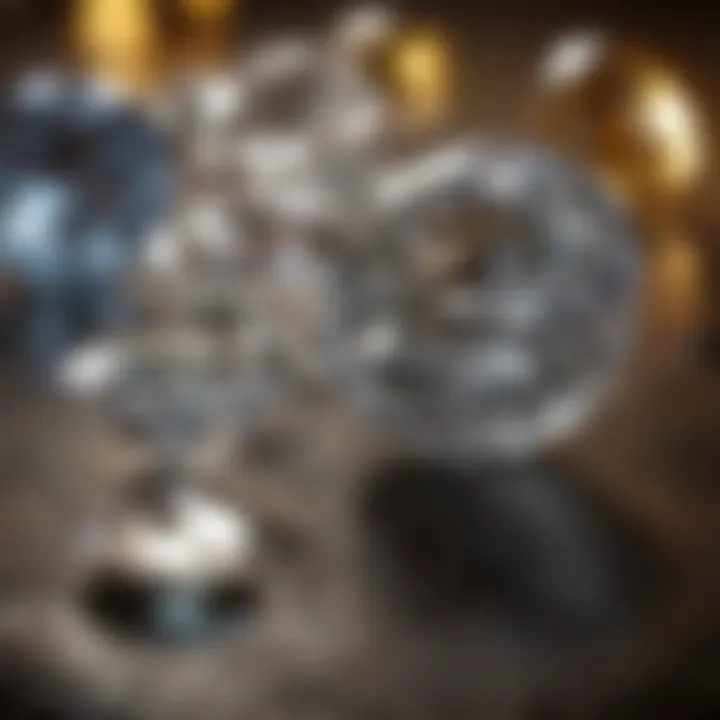
Understanding how birthstones are assigned can aid individuals in choosing jewelry that resonates with their identity and personal beliefs. As we continue this exploration into April's birthstone, the diamond, we uncover its unique properties, cultural relevance, and its powerful symbolism.
The April Birthstone: Diamond
The focus on diamonds, specifically as the April birthstone, opens a conversation about their multifaceted nature. Diamonds carry a unique significance across different cultures and contexts. Known for their beauty and durability, they symbolize various attributes. In this article, we will explore the characteristics and types of diamonds, along with their cultural relevance. Understanding these aspects can help buyers make informed choices when purchasing such a significant gemstone.
Characteristics of Diamonds
Physical Properties
Diamonds are renowned for their exceptional hardness, ranking a perfect ten on the Mohs scale. This physical property makes them highly resilient against scratches and wear. Their atomic structure, where carbon atoms are arranged in a crystal lattice, contributes to their stunning brilliance. This unique feature gives diamonds their sparkle, making them a favored choice for jewelry. However, it is important to consider that the hard nature of diamonds can also make them difficult to cut, requiring expert craftsmanship.
Color Variations
Diamonds are not just colorless; they come in various hues that define their character. The color range includes shades from near colorless to fancy pink, blue, and yellow options. Color variations expand the appeal of diamonds for different tastes and styles. While colorless diamonds are often seen as more valuable, fancy colored diamonds can command higher prices due to their rarity. However, buyers might find it challenging to determine the right color for their needs given the wide range available.
Clarity and Cut
The clarity of a diamond describes the presence of internal or external imperfections. Higher clarity grades typically result in greater value and beauty. Similarly, the cut of a diamond affects its ability to reflect light. A well-cut diamond showcases enhanced brilliance and sparkle. Buyers must navigate these qualities carefully, as they directly influence the gemstone's radiance and perceived worth. Nevertheless, if a budget is a concern, slightly lower clarity may provide a balance between beauty and price.
Types of Diamonds
Natural Diamonds
Natural diamonds form over billions of years through intense heat and pressure within the Earth’s mantle. Their unique history adds to their allure, as many buyers appreciate the authenticity and natural origins. They are often more desirable for engagement rings because of the sentimental value attached. However, sourcing natural diamonds can have ethical implications, making it essential for buyers to research the diamond’s provenance to ensure responsible buying.
Synthetic Diamonds
Synthetic diamonds, also known as lab-created diamonds, share the same physical and chemical composition as natural stones. They are produced using advanced technology, which allows for controlled environments for growth. A significant advantage of synthetic diamonds is their cost-effectiveness, often being cheaper than natural ones. Yet, some consumers feel they lack the sentimental value associated with their naturally formed counterparts. Transparent disclosure of their synthetic nature can help ensure trust and reliability in the purchase.
Fancy Color Diamonds
Fancy color diamonds are captivating because of their unique hues. Ranging from deep blues to vibrant yellows, they are rare and highly sought after. The grading of these diamonds is based not only on hue but also on tone and saturation. Buyers are often drawn to their distinctive appearance, making them suitable choices for unique pieces of jewelry. However, the high demand for specific colors can make fancy color diamonds quite expensive, potentially exceeding the budget of some buyers.
Cultural Significance of Diamonds
The cultural significance of diamonds extends beyond their physical attributes. Throughout history, they have been imbued with meanings that reflect society's values, beliefs, and ideas of beauty. This significance is not merely tied to aesthetics but is intricately linked to human emotions, heritage, and identity. The article aims to explore these dimensions, showcasing how diamonds resonate in various cultural contexts.
Historical Use in Various Cultures
Diamonds have been utilized across many cultures, serving different purposes and symbolizing various ideals. In ancient India, diamonds were considered sacred and believed to hold protective qualities. They adorned the crowns of royalty, representing power and authority. Similar customs arose in ancient Europe where diamonds became a symbol of divine favor, often reserved for the elite. The notion that they could ward off evil spirits enhanced their desirability.
In contrast, in some African cultures, diamonds are seen as emblematic of wealth and status. The discovery of diamonds in places like South Africa initiated significant social changes, influencing the fabric of society. Furthermore, these stones were often used in rituals, deeply rooted in communities' belief systems. Understanding these historical narratives adds depth to modern perceptions of diamonds.
Modern Symbolism
In contemporary society, diamonds carry an array of symbolic meanings, particularly in the realms of love and commitment, as well as strength and clarity.
Love and Commitment
The association of diamonds with love is perhaps one of the most recognized cultural significances. Engagement rings, featuring a diamond, represent a commitment that speaks of love's eternal nature. This tradition gained momentum in the 20th century, largely influenced by marketing efforts from major diamond companies. The emotional weight of a diamond ring is not just due to its beauty but also the sentiment it embodies.
From a psychological perspective, diamonds reinforce intentions of devotion and partnership. Their durability symbolizes a relationship's enduring strength. However, there is a unique consideration; this symbolism can put pressure on individuals to invest heavily in a diamond, leading to expectations that may overshadow the personal significance of the gesture.
Strength and Clarity
Diamonds are often viewed as emblems of strength and clarity. Their hardness makes them one of the most durable natural substances, thus representing resilience. This character trait mirrors personal growth and perseverance, making diamonds appealing to those who value these ideals.
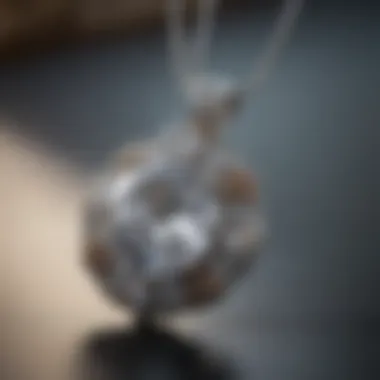
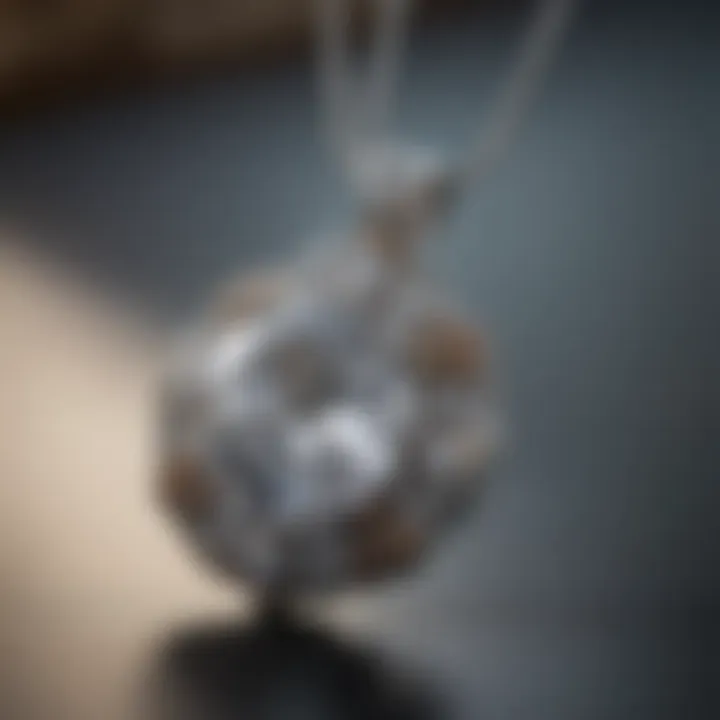
Furthermore, clarity in diamonds signifies transparency and truth. In modern contexts, individuals may bestow diamonds as tokens of honesty in relationships, whether romantic or platonic. However, the pursuit of a flawless diamond can be daunting. The pressure for perfection may create unrealistic benchmarks, overshadowing the true essence of the relationship itself.
In summary, the cultural significance of diamonds is rich and layered. Understanding their historical context and modern symbolism equips gemstone enthusiasts and consumers with the insight necessary to appreciate these precious stones beyond their market value.
Metaphysical Properties of Diamonds
Diamonds, known for their extraordinary brilliance and hardness, also have a rich tapestry of metaphysical properties attributed to them. This section explores these properties, shedding light on how diamonds are believed to influence physical, emotional, and spiritual well-being. For gemstone enthusiasts, understanding these aspects can enhance the appreciation of diamonds beyond their aesthetic qualities.
Crystal Healing Applications
Crystal healing is an ancient practice that involves using gemstones to promote health and healing. Diamonds, in this context, are often associated with various healing benefits:
- Energy Amplification: Diamonds are thought to amplify energy, both positive and negative. This quality can enhance the effects of other gemstones when used in combination.
- Emotional Clarity: It is believed that diamonds help clear the mind, allowing individuals to confront their emotions and make decisions with clarity.
- Physical Healing: Some practitioners claim that diamonds can aid in healing physical ailments, including issues related to the heart and blood disorders. However, scientific evidence supporting these claims remains limited.
"A diamond is not merely a gem; it is a vessel of healing and lightness."
Using diamonds in healing rituals often involves wearing the stone or placing it in a specific area of the home to encourage positive energy flow. However, personal belief in these practices heavily influences their effectiveness.
Spiritual Significance
The spiritual properties of diamonds encompass a wide array of beliefs, rooted in various cultures and traditions. Here are notable aspects of the spiritual significance attributed to diamonds:
- Connection to the Divine: Diamonds are often seen as symbols of purity and divine connection. Many cultures associate diamonds with enhancing spiritual growth and deepening one's faith.
- Protection: Traditionally, diamonds are believed to serve as a protective talisman against negative energies or attacks. This belief continues to resonate with individuals seeking emotional and spiritual safety.
- Illumination and Enlightenment: Because diamonds refract and reflect light spectacularly, they symbolize clarity and enlightenment. They are thought to inspire creativity and insight, fostering new ideas and perspectives.
These metaphysical properties of diamonds not only enrich their cultural significance but also allow individuals to explore the deeper meanings attached to these gemstones.
Choosing the Right Diamond
Selecting the right diamond is a critical step for anyone looking to buy jewelry, especially when considering the significance of diamonds as the April birthstone. The choice of a diamond affects both the aesthetic appeal and the value of the piece. Understanding key considerations will enable informed decisions during the buying process. This section provides crucial information on factors to contemplate, including budget and certification, and offers tips for first-time buyers.
Factors to Consider
Budget Considerations
Budget considerations play a major role in the diamond selection process. When setting a budget, it's vital to account for your financial situation while ensuring you select a quality stone. A thoughtful budget aids in narrowing down options. Consider that larger diamonds can be more expensive, but one does not always need to compromise on quality for size.
The unique feature here is the balance between quality and expense. Spending within a realistic range prevents future regrets while still allowing for a beautiful purchase. Careful planning of your budget provides peace of mind.
Certification and Grading
Certification and grading are essential when choosing a diamond. This involves understanding the quality markers set by recognized gemological institutes. A certified diamond guarantees authenticity and provides confidence in the purchase. Key characteristic here is the grading system, which evaluates the diamond based on the four Cs: carat, cut, clarity, and color. The unique feature of obtaining a graded diamond means consumers can compare stones confidently. Awareness of certification helps distinct your purchase, ensuring you receive the best value possible. Investing time to research certifications contributes positively to the overall goal of acquiring a quality diamond.
Tips for First-Time Buyers
For those purchasing their first diamond, it can be overwhelming. Here are some helpful tips:
- Do thorough research: Familiarize yourself with the qualities that define a good diamond.
- Visit multiple retailers: Comparing prices and options clarifies your understanding.
- Seek professional advice: Consult with gemologists or experienced jewelers.
- Consider the recipient's style: Knowing personal tastes will guide your selection.
- Be prepared to negotiate: Many retailers are willing to discuss prices and offer discounts.
By keeping these guidelines in mind, first-time buyers can gain confidence when navigating the world of diamonds.
Overall, understanding the nuances of selecting the right diamond will enhance the experience for potential buyers. The attributes of budgeting and certification should not be overlooked. They contribute significantly to the conviction and satisfaction in owning a diamond as an April birthstone.
Caring for Your Diamond
Caring for your diamond is crucial to maintain its beauty and integrity over time. Diamonds, being the hardest natural material, are incredibly durable, but they can still become dirty or scratched if not properly looked after. Regular care ensures that your diamond retains its brilliance and does not lose its appeal. Here are essential elements to consider when caring for your diamond, along with suggestions for cleaning and storage.
Cleaning Methods


Keeping your diamond clean is vital. A dirty diamond can appear dull and lose its sparkle. Here are methods for effective cleaning:
- Warm Soapy Water: Mix warm water with mild dish soap. Soak the diamond in the solution for about 20-30 minutes. After soaking, gently scrub it with a soft brush, like a toothbrush, ensuring to clean under the stone where dirt tends to accumulate.
- Ultrasonic Cleaners: These devices use sound waves to agitate a cleaning solution, effectively removing dirt and grime. However, be cautious as ultrasonic cleaners may not be suitable for all diamonds, especially those with fractures or inclusions.
- Professional Cleaning: Taking your diamond jewelry to a jeweler for professional cleaning at least once a year is advisable. They have the proper tools and techniques to clean and check for any potential damage.
Diamonds should be cleaned regularly to maintain their brilliance. A clean diamond enhances your overall appearance and ensures it lasts over time.
Storage Recommendations
Proper storage is just as important as cleaning. How and where you store your diamond can prevent scratches and other damage. Consider these recommendations:
- Individual Soft Pouches: Store your diamond jewelry in soft fabric pouches to prevent scratching against other jewelry.
- Jewelry Boxes with Dividers: A dedicated jewelry box allows for organized storage. Choose one with padded compartments to keep pieces separate.
- Avoiding Exposure: Store diamonds away from extreme temperatures or humidity, which can negatively impact the settings or other components of the jewelry.
In summary, caring for your diamond involves regular cleaning and proper storage. By following these guidelines, you can ensure your diamond remains a stunning emblem of elegance for years to come.
Diamonds in Jewelry
Diamonds are one of the most sought-after gemstones in the world, renowned for their exceptional beauty and durability. Their significance in jewelry is particularly noteworthy, as they symbolize various important aspects of life. This section will explore how diamonds are integrated into popular jewelry styles and the trends surrounding their design.
Popular Jewelry Styles Featuring Diamonds
Diamonds are primarily known for enhancing various types of jewelry. Their aesthetic appeal appeals to a wide audience, making them suitable for numerous occasions. The most common styles include engagement rings, necklaces, and earrings.
Engagement Rings
Engagement rings featuring diamonds hold a prominent place in jewelry traditions. The key characteristic of these rings is the symbolic representation of everlasting love and commitment. Diamonds are chosen for their hardness; they symbolize strength and durability—qualities desired in relationships.
The unique feature of diamond engagement rings is that they often have a central diamond, which can come in various shapes like round, oval, or princess cuts. This variety allows couples to select styles that reflect personal preferences. Engagement rings, although beautiful, can be quite costly. This is an important factor for many buyers.
Necklaces
Diamonds in necklaces offer elegance and luxury. They can be incorporated in many styles, including pendants or as part of intricate designs. Their key characteristic is versatility, meaning they can complement casual wear or formally elegant outfits.
A unique feature of diamond necklaces is their ability to catch light due to their cut, enhancing visual appeal. They can be layered with other necklaces or worn alone for a minimalistic look. The downside is that some designs can be quite heavy, making them less comfortable for extended wear.
Earrings
Diamond earrings add a sparkle that catches attention. They are often crafted as studs, hoops, or drop earrings. The key characteristic of diamond earrings is their simplicity combined with stunning brilliance. They work well for both daily wear and special occasions.
One unique feature is the variety of settings available, such as prong or bezel settings. This allows owners to choose based on personal preference and style. However, diamond earrings can be an investment, and their cost can be higher compared to other materials.
Trends in Diamond Jewelry Design
Various trends influence how diamonds are used in jewelry design today. Eco-friendly practices are becoming more common, with more buyers seeking conflict-free diamonds. Custom designs are also gaining popularity, where consumers want unique pieces that reflect their personal stories. This trend emphasizes individuality, diverging from traditional designs that have dominated the market for years.
"The diamond industry is evolving. More consumers are informed about their choices, pushing for ethically sourced diamonds."
Staying updated on current trends can benefit both buyers and jewelry designers. This allows them to create or select pieces that are not only beautiful but also timeless in style.
The End
The conclusion of this article is crucial, as it synthesizes the wealth of information presented. Readers gain a comprehensive understanding of the April birthstone, specifically the diamond. Key aspects such as its characteristics, cultural significance, and practical advice for purchasers are revisited. This section not only reinforces earlier points but also emphasizes real-world applications and the timeless appeal of diamonds.
Recap of the April Birthstone
To recap, diamonds hold a prominent place as the April birthstone. Their unmatched hardness and brilliance make them a symbol of strength and everlasting love. Historically, they have adorned royalty and have been associated with great power. The cultural context illustrates their role in various rituals, ceremonies, and even as status symbols. Additionally, diamonds come in various types, including natural, synthetic, and fancy colored diamonds, each offering unique qualities for enthusiasts and buyers alike.
Final Thoughts on Diamonds
In closing, diamonds extend beyond mere aesthetics. They represent enduring qualities such as clarity and strength. For those in search of meaningful gifts or valuable investments, understanding the nuances of diamonds is essential. From selecting the right type to caring for them, there are practical considerations every buyer should be aware of. The quest for the perfect diamond is as much about personal connection as it is about the stone's inherent value.
"Diamonds are more than beautiful; they reflect the connections we hold dear."
By digesting the significance of diamonds, one can appreciate their beauty fully while recognizing the profound meanings intertwined with them.



